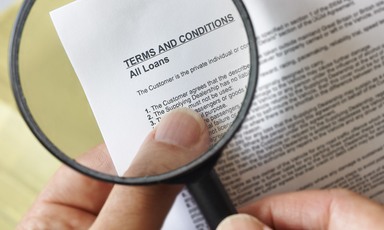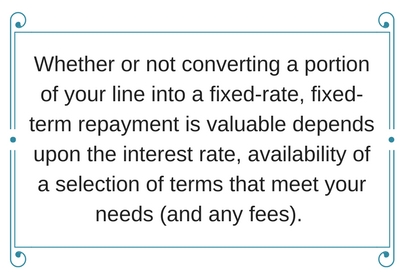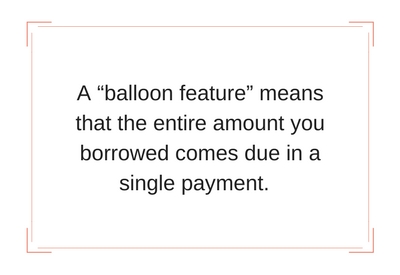 Some home equity loans and lines of credit have unique or unusual features. It's possible that your home equity loan or home equity line of credit (HELOC) may feature some of the terms described in this article.
Some home equity loans and lines of credit have unique or unusual features. It's possible that your home equity loan or home equity line of credit (HELOC) may feature some of the terms described in this article.
Convertible lines, fixed-rate "blocks" and loans within lines
A few lenders offer a home equity line of credit that starts with a variable-rate but can be fully converted to a fixed-rate after a few years. While those are rather rare, what is becoming more commonplace are HELOCs that allow you to "break off" a piece of your line and turn it into a fixed-rate, fixed-term loan.
These appear to be replacing the old traditional second mortgage (lump-sum home equity loan) at many lenders. Why? Blame it on changes to disclosure requirements and mortgage regulations; a portion of the Dodd-Frank Act enacted after the Great Recession covers closed-end credit, such as first mortgages and home equity loans, but does not apply to "open end" forms of credit such as home equity lines. Complying with these regulations is costly and burdensome for banks, and while first mortgages represent significant interest income and can be easily bought and sold, that's not the case with relatively low interest yield and lack of liquidity that second-lien position loans and lines afford to lenders.
Markets are creative things, and a useful idea solves the issue for both banks and borrowers alike: home equity lines of credit that allow portions to be put into fixed-rate, fixed-term sections. These are routinely called "loans within lines" or "fixed-rate loan options" or by other names, but they essentially all work in the same way.
 Once you have established a line of credit, let's say for $50,000, any money you use is subject to a variable interest rate; let's call this a rate of Prime + 2 percent. As we discuss elsewhere in this guide, payments on this amount may be subject to rising rates and may only cover interest (or interest plus a small fraction of the principal borrowed). Let's say that you draw $10,000 of your equity to consolidate some credit card debts.
Once you have established a line of credit, let's say for $50,000, any money you use is subject to a variable interest rate; let's call this a rate of Prime + 2 percent. As we discuss elsewhere in this guide, payments on this amount may be subject to rising rates and may only cover interest (or interest plus a small fraction of the principal borrowed). Let's say that you draw $10,000 of your equity to consolidate some credit card debts.
If interest rates are rising, you may become concerned about your ability to manage rising costs over time, or simply wish to have a known, fixed monthly payment to budget for each month, or want to make sure that you get all the potential benefits of your debt consolidation by paying down the new lower cost debt as quickly as possible. These goals can be accomplished by converting a piece of your available line -- the $10,000 you drew -- into a fixed-rate, fixed-term portion.
It may be that the lender offers to allow you to put that $10,000 into a 5 or 10-year payment plan with a fixed interest rate a little higher than your present prime + 2 percent offer. By fixing the interest rate and term, you preempt exposing your debt to interest rates that could be higher than this in the coming years. In return, you get a known and fixed monthly payment comprising both principal and interest, so you know exactly when this debt will be retired and how much interest you'll spend.
Also, as this loan is within your line of credit, retiring the loan means that credit available in the unused portion of your line -- initially reduced by the full $10,000, leaving $40,000 accessible -- begins to expand again, heading back toward the full $50,000 you started with as you make regular payments. You can get the certainty of cost that the old lump-sum home equity loan offered, but retain the flexibility that a line of credit provides.
Of course, whether or not converting a portion of your line into a fixed-rate, fixed-term repayment is valuable depends upon the interest rate, availability of a selection of terms that meet your needs (and any fees). Not all HELOC offers have such a feature, but if you are interested in this (or think you may be in the future) ask about it and understand your options before you sign on the dotted line.
Balloon home equity loans and HELOCs
A "balloon" feature on a line of credit means that the entire amount you borrowed comes due in a single future payment. One of the more common balloons has a ten-year term -- it's a revolving line of credit for ten years; you pay interest only (or add principal at your convenience). At the end of the 10-year term, any remaining balance is then required to be repaid. Some lenders may let you renegotiate any remaining balance into a new loan (like a fixed-rate loan) and issue you a new payback schedule, although this isn't always the case.
 The 'termless' home equity line of credit
The 'termless' home equity line of credit
Some rare home equity lines are true revolving lines of credit; by "true", we mean that they last for as long as you remain in the home (and keep up the payments on the line). Just like your trusty credit card, you can borrow right up to the preset limit, and are billed for a percentage of the outstanding balance each month.
This type of line can have drawbacks, however; most lenders offering this type of HELOC have regularly scheduled review periods, typically every one or two years. While this doesn't mean that you'll have to reapply for your home equity line every year or two, it does mean that if you've had a considerable change in credit history, lost your job, or your house has depreciated, the lender can modify the terms of your line. An unfavorable review can cause an immediate shutdown of your borrowing capability, and require you to begin a fixed-term repayment schedule if you have any outstanding balance.
The next section in HSH.com's home equity loan and HELOC guide addresses the nuts and bolts of how loans and lines are priced, including fees and taxes and examines potential risks associated with these products.
Next article: Home equity loan and line pricing
Previous article: Common home equity and HELOC terms



